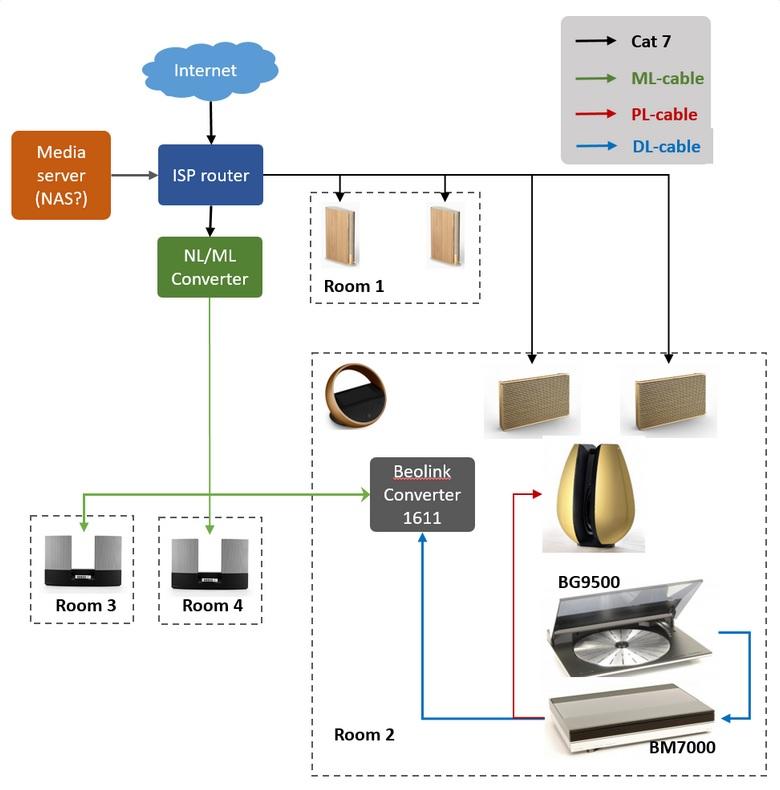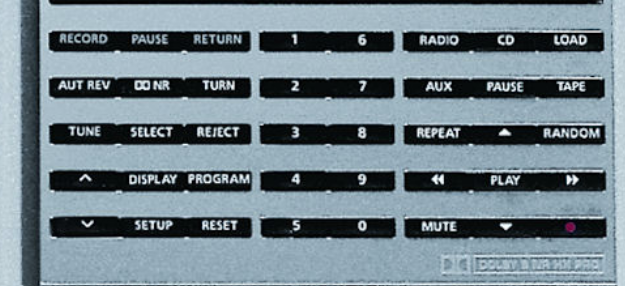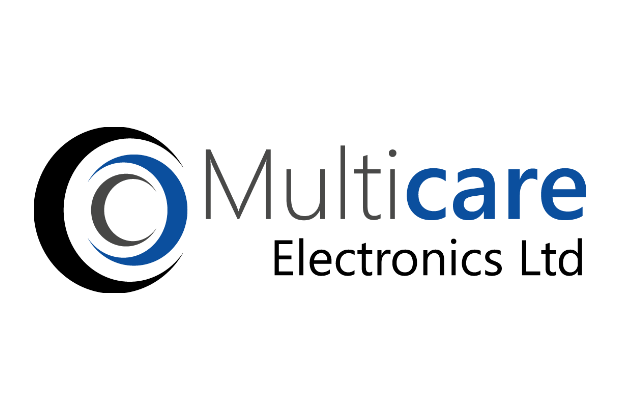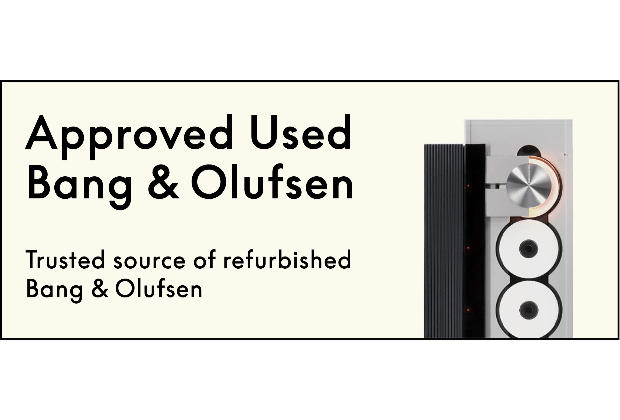- This topic has 86 replies, 7 voices, and was last updated 1 year, 2 months ago by
Tignum.
- AuthorPosts
- 23 September 2022 at 08:56 #39171
Hi all Link-system gurus. I have a question to which I hope you can help me find an answer to.
Consider a NL-system wiht a few newer Beosounds connected to a Masterlink network (through NL/ML converter) system. I would like to connect a Beogram 9500 to this network but I also want to be able to control the Beogram remotely (through a Beoremote Halo).
I know from previous advice I’ve received in this forum that it is possible if connect the Beogram to a Beomaster with Datalink and then connect the Beomaster to the Masterlink network, using a Beolink converter (type 1611).
What I wonder is if the Beolink converter can manage to convert Datalink signals from Beomaster to Masterlink signals, shouldn’t it also be able to convert Datalink signals from the Beogram to Masterlink, without the Beogram being connected to a Beomaster? I understand that the ML-network require an audio master but since the whole network is connected to the Network-link and there are several audio sources in the NL-network, will the existence of an audio master, be necessary?
24 September 2022 at 03:43 #39172Beogram control over masterlink has been raised several times in the archived forum. Unfortunately I don’t think anyone got it to work as required!
This thread is worth a read if you use Google translate: https://archivedforum2.beoworld.ouronlineserver.com/forums/p/11690/102249.aspx#102249
You may be able to use a workaround to get sound distributed, but full control does not seem to be possible.
24 September 2022 at 05:59 #39173Beogram control over masterlink has been raised several times in the archived forum. Unfortunately I don’t think anyone got it to work as required! This thread is worth a read if you use Google translate: https://archivedforum2.beoworld.ouronlineserver.com/forums/p/11690/102249.aspx#102249 You may be able to use a workaround to get sound distributed, but full control does not seem to be possible.
It is possible, but not to my knowledge on the proposed way: for example,
Beosystem 7000 (Beomaster 7000 option 0) datalink connected to a Beolink converter T1611, which is ML connected to a Beolink converter NL/ML (BLC; set as ASlave).
Set the Beosystem 7000 sources “available” on the NL side.
Solution 1:
use of Beolink Intelligence: ALL the Beosystem 7000 sources are available (as part of the BLC sources) and programable to all NL & Beocontrol Link products.
Solution 2: No Beolink Intelligence.
If a NL device like a Core, A6, BS35, M3, M5,…. is available in the system set-up the BLC as “linked to other Products” as primary Beolink-product (note: you have to check the boxes of the BLC sources in the “local sources list” also).
In both cases the Halo and the apps Beoliving or/and B&o app can be used. There are/were some weird workarounds: for example, one started the Beogram 7000 as source of a Core: when expanding to multiroom, one first had to switch to BLC in the B&o app before expanding the experience (note: lately the way of using a BLC in the B&o app has improved though) .
24 September 2022 at 08:18 #39174Many thanks, Guy and Carolpa for your responses, which are highly appreciated. I will give solution 2 a try as I don’t own a Beomaster yet.
If I’m reading your response correctly, the second solution allows for the connection of a Beogram, directly to the ML-network (using a BL-converter), without needing a Beomaster 6500 or 7000.
It would still be good to understnad the difference in link signal between the signal from Beogrma to BL-converter to ML in one hand and Beogram to Beomaster to BL-converter to ML Will the signals be different?
25 September 2022 at 05:12 #39175Many thanks, Guy and Carolpa for your responses, which are highly appreciated. I will give solution 2 a try as I don’t own a Beomaster yet. If I’m reading your response correctly, the second solution allows for the connection of a Beogram, directly to the ML-network (using a BL-converter), without needing a Beomaster 6500 or 7000. It would still be good to understnad the difference in link signal between the signal from Beogrma to BL-converter to ML in one hand and Beogram to Beomaster to BL-converter to ML Will the signals be different?
You interpret my reply incorrectly. The Beomaster is needed.
you can’t use solution 1 or 2 without the first part of my post.
25 September 2022 at 06:37 #39176Thanks again Carolpa for the correction.
25 September 2022 at 11:48 #39177In order to look at other options, can you tell us what other B&O equipment (and with what connections) will be in the same room as your Beogram?
Also, have you thought about RIAA amplification? If connecting to a datalink-capable Beomaster/Beosound (or even 1611 converter) without an RIAA stage you will have to ensure that the datalink connections bypass your chosen pre-amp.
26 September 2022 at 02:11 #39181Many thanks, Guy for your explanations and valuable advice. I will add the Delay-box to my list of stuff to acquire. Also, thank you for the link to Iconic-AV. I will contact them for the RIAA preamp.
However, I still can’t stop thinking about the necessity of a Beomaster in the system. Please correct me if I’m wrong, but I believe that Beomaster was needed to receive the IR commands and convert them to DATA-link so that the Beogram can be controlled remotely (since it doesn’t have its own IR receiver).
In a system based on NL, however, necessary commands can be sent by Halo to the Beomaster (and through it to Beogram), enabling control of the Beogram. This signal is received from Halo -> NL -> NL/ML converter, which converts the signal to ML signals, and then the ML singles are converted again to DL signals (though BL Converter 1611) and sent from there to the Beogram (through the Beomaster).
Since it seems like the Beomaster is necessary, it would be great to understand what Beomaster does to the signal (if any) before it is sent to the Beogram. However, If there is no change to the signal, it should be possible to eliminate the Beomaster.
26 September 2022 at 02:28 #39182Many thanks, Guy for your explanations and valuable advice. I will add the Delay-box to my list of stuff to acquire. Also, thank you for the link to Iconic-AV. I will contact them for the RIAA preamp. However, I still can’t stop thinking about the necessity of a Beomaster in the system. Please correct me if I’m wrong, but I believe that Beomaster was needed to receive the IR commands and convert them to DATA-link so that the Beogram can be controlled remotely (since it doesn’t have its own IR receiver). In a system based on NL, however, necessary commands can be sent by Halo to the Beomaster (and through it to Beogram), enabling control of the Beogram. This signal is received from Halo -> NL -> NL/ML converter, which converts the signal to ML signals, and then the ML singles are converted again to DL signals (though BL Converter 1611) and sent from there to the Beogram (through the Beomaster). Since it seems like the Beomaster is necessary, it would be great to understand what Beomaster does to the signal (if any) before it is sent to the Beogram. However, If there is no change to the signal, it should be possible to eliminate the Beomaster.
1) you could connect the Beogram to the BLC (line-in), but you only can select the source line-in. You cannot control the Beogram (none at all, with or without RIAA preamp).
2) so there we have the difference, you need “brains” to control the Beogram! And these brains are provided by the Beomaster (nothing else will do).26 September 2022 at 03:26 #39183Thanks, Carolpa, for the explanation. Let’s put it this way. If in the above system, I send a signal to Beogram, for example, commanding, “start playing the record”. This signal will be an NL signal that will be sent to NL/ML converter. There it is converted to ML signal and from there to BLC, where it is finally translated to Dattalink commanding “play”.
The Beomaster receives this Datalink command and sends either the same command to the Beogram or does something with that command, so the Beogram understands it.
So, if I understand you correctly, the signals are different, so Beomaster does something to the original signal. However, It would be great to understand what it does to the signal. It would, for example, be great if the difference could be learnt so that NL-could, after some coding, send a proper signal that could communicate with the Beogram without necessary translation by the Beomaster, simply send signals that are ready to use to ht Beogram. This could make the Beomaster redundant, which has no function in modern B&O networks other than translating signals for the Beogram. The same could hold for Beocord or Beogram CD (if someone would like to use those sources).
26 September 2022 at 05:36 #39184Thanks, Carolpa, for the explanation. Let’s put it this way. If in the above system, I send a signal to Beogram, for example, commanding, “start playing the record”. This signal will be an NL signal that will be sent to NL/ML converter.
This is data signal sent to the right BLC, because on NL level it is know where the source is connected.
There it is converted to ML signal and from there to BLC, where it is finally translated to Dattalink commanding “play”.
ML data-address defines to which device it should send the command to
The Beomaster receives this Datalink command and sends either the same command to the Beogram or does something with that command, so the Beogram understands it.
The Beomaster translate the command to playing the Beogram.
So, if I understand you correctly, the signals are different, so Beomaster does something to the original signal.
Sorry but I do not understand what you mean with this remark. The BM simply follow the instruction given and starts the source. The same for the other devices. They, the commands, open a path for the source, Beogram, to be played in the linked system.
note:
- you have the audio signals
- you have the data signals for controlling the system
However, It would be great to understand what it does to the signal. It would, for example, be great if the difference could be learnt so that NL-could, after some coding, send a proper signal that could communicate with the Beogram without necessary translation by the Beomaster, simply send signals that are ready to use to ht Beogram. This could make the Beomaster redundant, which has no function in modern B&O networks other than translating signals for the Beogram. The same could hold for Beocord or Beogram CD (if someone would like to use those sources).
That would be a BLC with the additional logic of an integrated Beomaster (discussed before on the previous forum).
26 September 2022 at 08:58 #39178Thanks Guy, for offering your help.
Please see the below schematic for the planned B&O network. My idea was that since I’m not planning to use IRremote (but an NL-connected Halo remote), I might not need the Beomaster. It is a big chunky box that takes up space, and I don’t need it; above all, it is old and can die anytime. Also, I thought I wouldn’t need an Audiomaster as the integrated network is an NL network, which theoretically doesn’t necessitate an Audiomaster like ML. However, from what Carolpa wrote, it seems like the NL network will be the passive one, so I will need an audio master after all (or at least that is what I understand). I would, however, be happy if I could ditch the Beomaster, as long as I can remotely control the Beogram.
 26 September 2022 at 12:12 #39179
26 September 2022 at 12:12 #39179Great diagram – very clear!
I do think that you will have to use a Beomaster in order to then adopt one of Carolpa’s options. However, some observations:
- If you decide to use a BM7000, be aware that not all (not many?) are fitted with RIAA amplifiers which will be required for your BG9500.
- You could get rid of the BL1611 by using an audiomaster such as Beosound Ouverture, which as far as I know is the only Beomaster with both ML and datalink. However, you would still need an RIAA stage.
- In order to solve the RIAA requirement whilst still using datalink you could look for (or build) something like this (I am not sure if Iconic AV are still in business): http://www.iconic-av.co.uk/item/1321/RIAA+Pre-Amplifier+with+Datalink+for+BeoGrams/
- If connected as shown, then in Room 2 you would have a phase difference (sound delay) between the Beolab 11 and the Beosound Levels. The output from the Beomaster (and direct to the BeoLab 11) is analogue, but is converted to digital in the ML/NL converter (hence delay) and further converted back to analogue in the Levels (hence more delay). This is the reason why mixed ML NL systems often use a NL/ML delay box to ‘delay’ the analogue part of the system (ML) to match the digital part (NL). In your setup, such a box could only be introduced to match BM7000 output (to Beolab 11) to NL sources, not the other way around!
26 September 2022 at 12:21 #39180Further to the above, Iconic-AV do indeed still exist (based near me!) and also have a number of items listed on eBay here: https://www.ebay.co.uk/str/iconicav?_trksid=p2047675.m3561.l2563
I can’t see the RIAA pre-amp box listed but it could be worth getting in touch.
27 September 2022 at 01:05 #39191How can I find out if the RIAA is already fitted?
Not at all sure! I would hope that it is written on the label. The part number of the RIAA was 8001245.
You could test it with your BG9500. If not fitted then it would simply be very low level sound.
Or you could open it up and look for the small RIAA board which is plugged into the pre-amp PCB – I am not sure exactly where. Perhaps someone esle on the forum knows!
As an aside, I just found this FB post from earlier this year making reference to a chap called Søren Claudius who makes a retro fit RIAA module – he says it’s for BM7000 but I think the same module would fit the 6500. Have a look here: https://www.facebook.com/groups/2263448640/posts/10160172517103641/?comment_id=10160172597758641
27 September 2022 at 01:08 #39192And there are pictures of a genuine RIAA board attached to the first couple of posts here: https://archivedforum2.beoworld.ouronlineserver.com/forums/p/7576/67094.aspx#67094
I doubt that it’s still for sale!
27 September 2022 at 01:18 #39193A further thought: You have said that you will hide the BM6500 away. One of the reasons that (in later models) B&O moved the RIAA from the Beomaster to the Beogram was to allow Beograms to be sited further away from the Beomaster. By fitting the RIAA in the Beogram, a stronger signal was sent and a longer cable could be used.
With this in mind, you may wish to go for the Iconic-AV RIAA pre-amp and connect it quite close to the Beogram.
There’s so much to think about!
27 September 2022 at 07:03 #39185Carolpa,
The Beomaster translate the command to play the Beogram. So, if I understand you correctly, the signals are different, so Beomaster does something to the original signal. Sorry but I do not understand what you mean with this remark. The BM simply follow the instruction given and starts the source. The same for the other devices. They, the commands, open a path for the source, Beogram, to be played in the linked system.
I meant that somehow The BLC sends a command to the Beomaster, for example, “tell Beomaster to tell Beogram to start playing”. The Beomaster then recode it and send a message to Beogram “start playing”. These codes are, of course, in Datalink protocol. I meant that it would be great to recode the original message so it could emulate the Beomaster and send a direct message to the Beogram as if it came from the Beomaster.
Also, thanks for the tip about the old forum. I will search around there.
I also read somewhere that Beolink Gateway allows for coding master link commands. Please let me know if you have any clues about the possibility of achieving what I hope to do using the gateway or, even better, through NL/ML.
27 September 2022 at 07:25 #39186You could get rid of the BL1611 by using an audiomaster such as Beosound Ouverture, which as far as I know is the only Beomaster with both ML and datalink. However, you would still need an RIAA stage.
That would be a good option as it is much easier to find an overture out there than a Beomaster 6500 or 7000. Can overture control Beogram and command it to play, Stop, pause, skip forward or backwards? It seems like Overture doesn’t have a dedicated phono button, but AUX. will the Beogram understand that it is connected through AUX with full functionality?
 27 September 2022 at 09:54 #39187
27 September 2022 at 09:54 #39187Can overture control Beogram and command it to play, Stop, pause, skip forward or backwards?
Yes, it can do all of these. You can select from the front panel with AUX and it will recognise that a Beogram is connected and show PHONO on the display. You can also select with a remote using AUX or PHONO (or N.RADIO on a later Beo4). Remember that skipping forwards/backwards isn’t a track search as such – you are just moving the arm.
This thread describes Beogram control, albeit with a BG6500:https://archivedforum.beoworld.org/forums/p/28933/227854.aspx#227854
Unlike with the BG6500, your BG9500 will still need that RIAA add-on.
EDIT: Don’t be tempted by a later Beosound 3000/3200. Although these have a 7-pin aux socket, they do not have the datalink function hence will not control a Beogram.
- AuthorPosts
- You must be logged in to reply to this topic.





